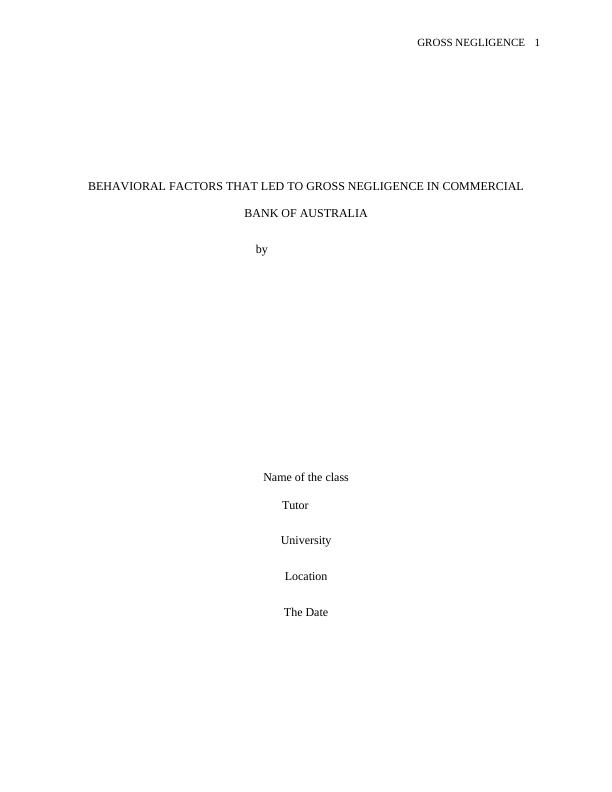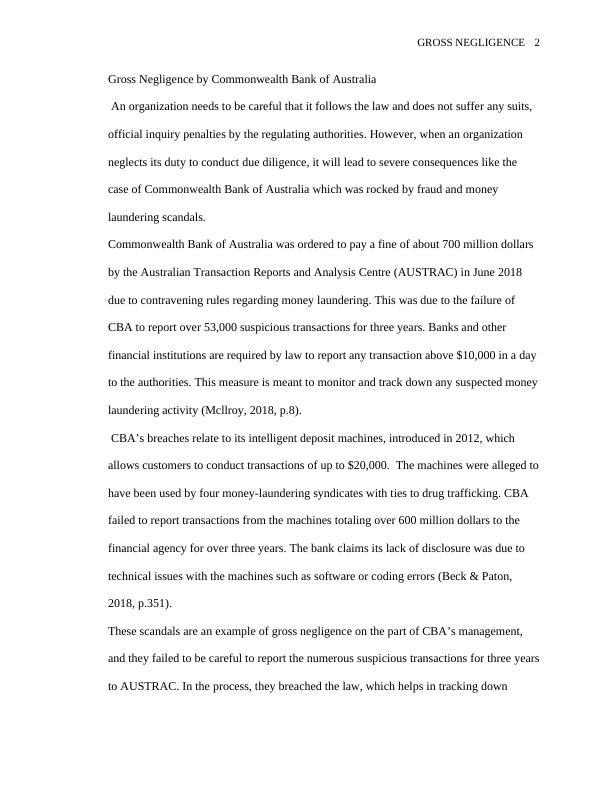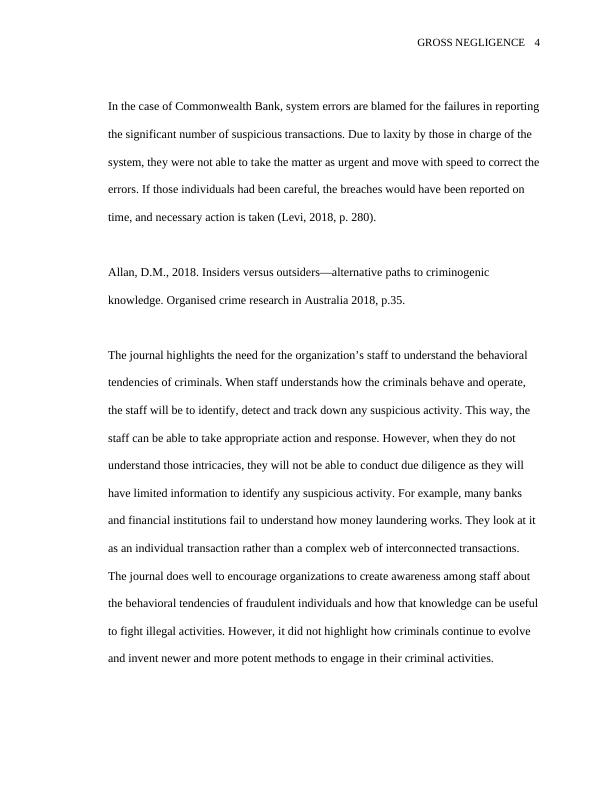Behavioral Factors Leading to Gross Negligence in Commonwealth Bank of Australia
Added on 2023-06-07
13 Pages2346 Words243 Views
GROSS NEGLIGENCE 1
BEHAVIORAL FACTORS THAT LED TO GROSS NEGLIGENCE IN COMMERCIAL
BANK OF AUSTRALIA
by
Name of the class
Tutor
University
Location
The Date
BEHAVIORAL FACTORS THAT LED TO GROSS NEGLIGENCE IN COMMERCIAL
BANK OF AUSTRALIA
by
Name of the class
Tutor
University
Location
The Date

GROSS NEGLIGENCE 2
Gross Negligence by Commonwealth Bank of Australia
An organization needs to be careful that it follows the law and does not suffer any suits,
official inquiry penalties by the regulating authorities. However, when an organization
neglects its duty to conduct due diligence, it will lead to severe consequences like the
case of Commonwealth Bank of Australia which was rocked by fraud and money
laundering scandals.
Commonwealth Bank of Australia was ordered to pay a fine of about 700 million dollars
by the Australian Transaction Reports and Analysis Centre (AUSTRAC) in June 2018
due to contravening rules regarding money laundering. This was due to the failure of
CBA to report over 53,000 suspicious transactions for three years. Banks and other
financial institutions are required by law to report any transaction above $10,000 in a day
to the authorities. This measure is meant to monitor and track down any suspected money
laundering activity (Mcllroy, 2018, p.8).
CBA’s breaches relate to its intelligent deposit machines, introduced in 2012, which
allows customers to conduct transactions of up to $20,000. The machines were alleged to
have been used by four money-laundering syndicates with ties to drug trafficking. CBA
failed to report transactions from the machines totaling over 600 million dollars to the
financial agency for over three years. The bank claims its lack of disclosure was due to
technical issues with the machines such as software or coding errors (Beck & Paton,
2018, p.351).
These scandals are an example of gross negligence on the part of CBA’s management,
and they failed to be careful to report the numerous suspicious transactions for three years
to AUSTRAC. In the process, they breached the law, which helps in tracking down
Gross Negligence by Commonwealth Bank of Australia
An organization needs to be careful that it follows the law and does not suffer any suits,
official inquiry penalties by the regulating authorities. However, when an organization
neglects its duty to conduct due diligence, it will lead to severe consequences like the
case of Commonwealth Bank of Australia which was rocked by fraud and money
laundering scandals.
Commonwealth Bank of Australia was ordered to pay a fine of about 700 million dollars
by the Australian Transaction Reports and Analysis Centre (AUSTRAC) in June 2018
due to contravening rules regarding money laundering. This was due to the failure of
CBA to report over 53,000 suspicious transactions for three years. Banks and other
financial institutions are required by law to report any transaction above $10,000 in a day
to the authorities. This measure is meant to monitor and track down any suspected money
laundering activity (Mcllroy, 2018, p.8).
CBA’s breaches relate to its intelligent deposit machines, introduced in 2012, which
allows customers to conduct transactions of up to $20,000. The machines were alleged to
have been used by four money-laundering syndicates with ties to drug trafficking. CBA
failed to report transactions from the machines totaling over 600 million dollars to the
financial agency for over three years. The bank claims its lack of disclosure was due to
technical issues with the machines such as software or coding errors (Beck & Paton,
2018, p.351).
These scandals are an example of gross negligence on the part of CBA’s management,
and they failed to be careful to report the numerous suspicious transactions for three years
to AUSTRAC. In the process, they breached the law, which helps in tracking down

GROSS NEGLIGENCE 3
money laundering activities. As a result, CBA suffered a significant financial loss. The
organizational failures also led to the stepping down of its CEO, Ian Narev, who took
responsibility for the scandals that have rocked the bank. Therefore, this paper is going to
consider the behavioral issues that caused gross negligence on the part of CBA and led to
the fraud and money laundering scandal (Schmulow & O’Hara, 2018, p. 30).
.
Behavioral factors that led to gross negligence by Commonwealth Bank
Let’s take a look at the following five annotated bibliographies that offers contemporary
research that explain the behavioral issues within an organization that can cause gross
negligence
Burke, W.W., 2017. Organization change: Theory and practice. Sage Publications.
The author explains that when individuals within an organization do not understand the
severity or sensitivity of an issue they fail to be careful in their activities. The employees
may not understand the long-term consequences an organization faces if it is not careful
enough to follow laid down rules. They may show laxity in their approach and may not
take any appropriate action in case of any alerts.
The strength of the article is how it serves to highlight the importance of the management
team to stress on its staff the consequences of their actions and how the organization will
suffer in case they neglect their duties. However, it does not mention the concrete
measures an organization can take to address this problem.
money laundering activities. As a result, CBA suffered a significant financial loss. The
organizational failures also led to the stepping down of its CEO, Ian Narev, who took
responsibility for the scandals that have rocked the bank. Therefore, this paper is going to
consider the behavioral issues that caused gross negligence on the part of CBA and led to
the fraud and money laundering scandal (Schmulow & O’Hara, 2018, p. 30).
.
Behavioral factors that led to gross negligence by Commonwealth Bank
Let’s take a look at the following five annotated bibliographies that offers contemporary
research that explain the behavioral issues within an organization that can cause gross
negligence
Burke, W.W., 2017. Organization change: Theory and practice. Sage Publications.
The author explains that when individuals within an organization do not understand the
severity or sensitivity of an issue they fail to be careful in their activities. The employees
may not understand the long-term consequences an organization faces if it is not careful
enough to follow laid down rules. They may show laxity in their approach and may not
take any appropriate action in case of any alerts.
The strength of the article is how it serves to highlight the importance of the management
team to stress on its staff the consequences of their actions and how the organization will
suffer in case they neglect their duties. However, it does not mention the concrete
measures an organization can take to address this problem.

GROSS NEGLIGENCE 4
In the case of Commonwealth Bank, system errors are blamed for the failures in reporting
the significant number of suspicious transactions. Due to laxity by those in charge of the
system, they were not able to take the matter as urgent and move with speed to correct the
errors. If those individuals had been careful, the breaches would have been reported on
time, and necessary action is taken (Levi, 2018, p. 280).
Allan, D.M., 2018. Insiders versus outsiders—alternative paths to criminogenic
knowledge. Organised crime research in Australia 2018, p.35.
The journal highlights the need for the organization’s staff to understand the behavioral
tendencies of criminals. When staff understands how the criminals behave and operate,
the staff will be to identify, detect and track down any suspicious activity. This way, the
staff can be able to take appropriate action and response. However, when they do not
understand those intricacies, they will not be able to conduct due diligence as they will
have limited information to identify any suspicious activity. For example, many banks
and financial institutions fail to understand how money laundering works. They look at it
as an individual transaction rather than a complex web of interconnected transactions.
The journal does well to encourage organizations to create awareness among staff about
the behavioral tendencies of fraudulent individuals and how that knowledge can be useful
to fight illegal activities. However, it did not highlight how criminals continue to evolve
and invent newer and more potent methods to engage in their criminal activities.
In the case of Commonwealth Bank, system errors are blamed for the failures in reporting
the significant number of suspicious transactions. Due to laxity by those in charge of the
system, they were not able to take the matter as urgent and move with speed to correct the
errors. If those individuals had been careful, the breaches would have been reported on
time, and necessary action is taken (Levi, 2018, p. 280).
Allan, D.M., 2018. Insiders versus outsiders—alternative paths to criminogenic
knowledge. Organised crime research in Australia 2018, p.35.
The journal highlights the need for the organization’s staff to understand the behavioral
tendencies of criminals. When staff understands how the criminals behave and operate,
the staff will be to identify, detect and track down any suspicious activity. This way, the
staff can be able to take appropriate action and response. However, when they do not
understand those intricacies, they will not be able to conduct due diligence as they will
have limited information to identify any suspicious activity. For example, many banks
and financial institutions fail to understand how money laundering works. They look at it
as an individual transaction rather than a complex web of interconnected transactions.
The journal does well to encourage organizations to create awareness among staff about
the behavioral tendencies of fraudulent individuals and how that knowledge can be useful
to fight illegal activities. However, it did not highlight how criminals continue to evolve
and invent newer and more potent methods to engage in their criminal activities.

End of preview
Want to access all the pages? Upload your documents or become a member.
Related Documents
Commonwealth Bank of Australia (CBA) Money Laundering Scandallg...
|10
|2949
|468
CBA Fraud and Money Laundering Case Studylg...
|13
|3303
|300
Commonwealth Bank of Australia's Anti-Money Laundering Breachlg...
|7
|1869
|168
CBA Money Laundering Scandallg...
|10
|2310
|15
Money Laundering Scandal in Commonwealth Bank of Australialg...
|10
|2326
|314
Law of Financial Institution and Security: Assignmentlg...
|11
|2786
|127